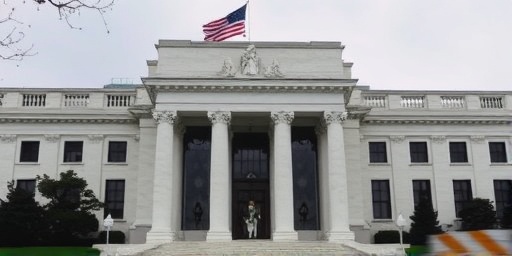U.S. stock futures tumbled sharply in pre-market trading on Wednesday, dragging global markets into a sea of uncertainty after Federal Reserve officials delivered starkly divergent messages on the path forward for interest rates. The conflicting signals from the U.S. central bank have amplified fears of prolonged market volatility, with investors grappling to decipher the Fed’s next moves in its monetary policy framework. As Fed policy remains a pivotal force shaping the stock market, this discord has erased early-year gains and sparked a broader sell-off across Asia and Europe.
The Dow Jones Industrial Average futures dropped 0.8%, or about 320 points, while S&P 500 futures shed 1.1% and Nasdaq futures plunged 1.4%. This comes hot on the heels of a mixed session on Wall Street, where tech-heavy indices had clung to slim recoveries despite persistent inflation worries. Overseas, Japan’s Nikkei 225 index fell 1.2% at open, and London’s FTSE 100 was down 0.7%, reflecting the ripple effects of U.S. monetary policy uncertainties.
Fed Hawks and Doves Divide on Rate Cut Urgency
The root of today’s market jitters lies in the polarized rhetoric emerging from the Federal Reserve’s ranks. In a series of speeches and interviews over the past 48 hours, key officials have painted contrasting pictures of when—and if—interest rates might ease from their current multi-year highs. Fed Chair Jerome Powell, speaking at an economic forum in Washington, struck a cautious tone, emphasizing that recent data on resilient consumer spending and stubborn wage growth necessitate a ‘patient approach’ to any Fed policy shifts.
‘We are not rushing into rate cuts; the economy’s strength allows us to monitor inflation closely without premature action,’ Powell stated, underscoring the central bank’s commitment to its 2% inflation target. This dovish-leaning remark, however, was quickly undercut by hawkish voices from regional Fed presidents. Raphael Bostic of the Atlanta Fed warned in a Bloomberg interview that ‘global trade tensions and supply chain disruptions could reignite inflationary pressures,’ advocating for sustained higher rates well into 2024 to prevent overheating.
Contrasting Bostic’s stance, San Francisco Fed President Mary Daly offered a more balanced view during a panel at the Economic Club of New York. ‘If labor market data softens as anticipated, we could see rate cuts by mid-year, but it’s data-dependent,’ Daly said, injecting a sliver of optimism that briefly buoyed futures before the broader hawkish narrative took hold. These diverging views highlight deep internal debates within the Fed, reminiscent of the policy rifts seen during the 2018-2019 rate hike cycle, which ultimately triggered a market correction.
Market analysts point to the FOMC minutes from the latest meeting, released earlier this week, as a catalyst. The document revealed that while a majority of officials still project two rate cuts in 2024, a notable minority favors none, citing risks from geopolitical events like the ongoing Ukraine conflict and Middle East instability. This split has widened the VIX index, Wall Street’s ‘fear gauge,’ to 18.5—its highest level since November—signaling elevated market volatility ahead.
U.S. Stock Futures Lead the Downward Spiral
The immediate fallout from these Fed policy pronouncements was evident in the sharp decline of U.S. stock futures, which set a bearish tone for the trading day. The S&P 500, a bellwether for broader stock market health, is now teetering on the edge of entering correction territory, down approximately 8% from its mid-January peak. Tech stocks, particularly those sensitive to interest rates, bore the brunt: futures for Apple and Microsoft each fell over 1.5%, while semiconductor giant Nvidia dropped 2.1% amid fears that higher-for-longer rates could crimp growth in AI-driven sectors.
Financials and consumer discretionary stocks also suffered, with JPMorgan Chase futures down 1% and Amazon slipping 1.3%. This sector rotation away from high-growth names underscores investor pivots toward defensive plays like utilities and healthcare, which saw milder declines of 0.3% to 0.5%. Bond yields reacted swiftly too; the 10-year U.S. Treasury yield climbed to 4.25%, up from 4.05% just days ago, as traders priced in delayed monetary policy easing.
Globally, the contagion spread rapidly. In Europe, Germany’s DAX index opened 1.1% lower, pressured by export-dependent firms wary of a stronger dollar eroding competitiveness. Asian markets closed lower across the board: Hong Kong’s Hang Seng fell 1.8%, dragged by property developers, while South Korea’s Kospi declined 1.3% on tech export concerns. Emerging markets weren’t spared; Brazil’s Bovespa dropped 0.9%, highlighting how U.S. Fed policy reverberates through interconnected global finance.
Historical parallels are instructive here. During the 2015 ‘taper tantrum,’ similar Fed communication misfires led to a 10% stock market pullback over three months. Economists at Goldman Sachs noted in a research note that current conditions echo that era, with market volatility potentially persisting until the Fed provides clearer guidance at its March meeting.
Tech and Pharma Earnings Reports Loom Large
As markets digest the Fed’s mixed messages, all eyes are turning to a packed slate of corporate earnings that could either exacerbate or mitigate the market volatility. Later today, Advanced Micro Devices (AMD) is set to report its fourth-quarter results, with analysts expecting revenue of $6.16 billion—a 9% year-over-year increase—fueled by demand for AI chips. However, whispers of softening PC sales and competition from Nvidia have tempered optimism; AMD shares are down 1.2% in pre-market.
Ride-hailing leader Uber Technologies follows with its earnings call, projected to show $9.5 billion in Q4 revenue, up 15% amid post-pandemic travel surges. Yet, rising labor costs and regulatory scrutiny in key markets like Europe could pressure margins. Uber’s stock dipped 0.9%, reflecting investor caution in a high-interest rates environment that squeezes consumer spending.
Pharmaceutical heavyweight Pfizer rounds out the marquee reports, anticipating $14.1 billion in sales, down slightly due to the waning COVID-19 booster demand but buoyed by its oncology pipeline. CEO Albert Bourla recently hinted at aggressive cost-cutting to offset patent cliffs, but any guidance below expectations could amplify sector-wide jitters. Pfizer futures are off 0.7%.
Not to be overlooked, Thomson Reuters will disclose its figures, with forecasts calling for 6% revenue growth to $1.7 billion, driven by legal and tax software subscriptions. As a barometer for professional services, its results could signal broader economic resilience amid monetary policy tightening. Thomson Reuters shares held steady, down just 0.2%.
These reports arrive at a critical juncture. Earnings season has thus far disappointed, with 72% of S&P 500 companies beating estimates but overall guidance subdued due to interest rates headwinds. FactSet data shows forward earnings growth revised down to 11% for 2024 from 12% a month ago, underscoring how Fed policy uncertainties are curbing corporate outlooks.
Key Metrics to Watch in Today’s Earnings
- AMD: AI chip sales and gross margins amid supply chain tweaks.
- Uber: Ride volume growth and profitability in international markets.
- Pfizer: Non-COVID revenue streams and R&D investment plans.
- Thomson Reuters: Subscription renewal rates and AI integration progress.
Wall Street consensus, per Bloomberg, pegs the combined impact of these reports as pivotal: strong beats could stem the stock market bleed, while misses might push indices toward bear market thresholds.
Analysts Forecast Prolonged Volatility and Investor Strategies
With Fed policy in flux, market strategists are bracing for choppy waters. BlackRock’s chief investment officer, Rick Rieder, commented in a CNBC interview: ‘The Fed’s mixed signals are creating a fog of uncertainty; expect market volatility to linger until we get concrete data on jobs and inflation.’ Rieder advises diversification into inflation-protected assets like TIPS and gold, which surged 0.5% today.
At Morgan Stanley, analyst Mike Wilson highlighted the interest rates conundrum: ‘Higher yields are punishing growth stocks, but they also offer value in fixed income. Investors should rotate into quality dividend payers.’ Indeed, dividend aristocrats like Procter & Gamble rose 0.4% in futures, bucking the trend.
Broader economic indicators add to the mix. The latest ISM manufacturing index came in at 47.8, signaling contraction, while unemployment claims ticked up to 220,000—hints of cooling that could sway the Fed toward cuts but also stoke recession fears. Consumer confidence, per Conference Board data, slipped to 108.6 in February, down from 110.9, as monetary policy tightness bites into household budgets.
Geopolitical risks amplify the volatility: escalating U.S.-China trade frictions, with new tariffs on electric vehicles, threaten supply chains for the very companies reporting today. Oil prices, meanwhile, hovered at $78 per barrel, providing some buffer for energy stocks but pressuring transportation firms like Uber.
Looking ahead, the Fed’s next policy meeting in late March looms large, where dot plot updates could clarify the rate cut trajectory. Investors are also eyeing upcoming CPI data on February 13, expected to show 3.1% year-over-year inflation—any upside surprise could solidify hawkish biases.
For the global economy, this episode underscores the Fed’s outsized influence. Emerging markets, already strained by dollar strength, face capital outflows; India’s Sensex fell 1% today, while Mexico’s IPC dropped 0.8%. Central banks worldwide, from the ECB to the Bank of Japan, are watching closely, with the ECB’s own rate decisions potentially delayed in solidarity with U.S. monetary policy.
In the weeks to come, savvy investors may find opportunities in the dips. Value stocks in financials and industrials could rebound if interest rates stabilize, while tech’s long-term AI narrative remains intact despite short-term pain. As one veteran trader put it, ‘Volatility is the price of admission in uncertain times—those who navigate it wisely will emerge stronger.’ The path forward hinges on whether the Fed can harmonize its voices and restore market confidence.









